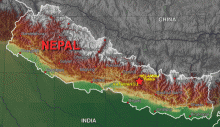Regional Background
Nepal is a small country packed between two giant countries China and India. Culturally and religiously, it has been a very peaceful country until recently it has broken this tradition and turned to an awful political unrest. Despite everything, Nepal remains a land of spirituality. The cultural and linguistic diversity in Nepal adds to our beauty, thus making every other community an interesting and different place. The countless number of temples and monasteries that one can see here works as a center of faith for all the people and is what keeps the unity of the people intact. The two largest religions of Nepal Hinduism and Buddhism in Nepal share a special relationship keeping away any threat of religious tension between these two. The Lord Buddha, a peace messenger born in the southern part of Nepal took birth in a Hindu family.
Country Statistics
| Country (long form) | Kingdom of Nepal |
| Capital | Kathmandu |
| Total Area |
54,363.18 sq mi 140,800.00 sq km (slightly larger than Arkansas) |
| Population | 25,284,463 (July 2001 est.) |
| Estimated Population in 2050 | 53,293,874 |
| Languages |
Nepali (official; spoken by 90% of the population), about a dozen other languages and about 30 major dialects note: many in government and business also speak English (1995) |
| Literacy | 27.5% total, 40.9% male, 14% female (1995 est.) |
| Religions |
Hinduism 86.2%, Buddhism 7.8%, Islam 3.8%, other 2.2% note: only official Hindu state in the world (1995) |
| Life Expectancy | 58.65 male, 57.77 female (2001 est.) |
| Government Type | parliamentary democracy and constitutional monarchy |
| Currency | 1 Nepalese rupee (NR) = 100 paisa |
| GDP (per capita) | $1,360 (2000 est.) |
| Industry | tourism, carpet, textile; small rice, jute, sugar, and oilseed mills; cigarette; cement and brick production |
| Agriculture | rice, corn, wheat, sugarcane, root crops; milk, water buffalo meat |
| Arable Land | 17% |
| Natural Resources | quartz, water, timber, hydropower, scenic beauty, small deposits of lignite, copper, cobalt, iron ore |





